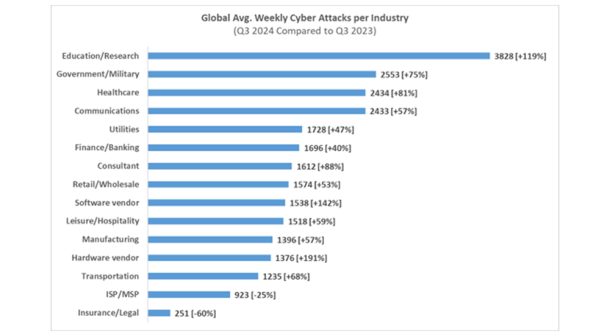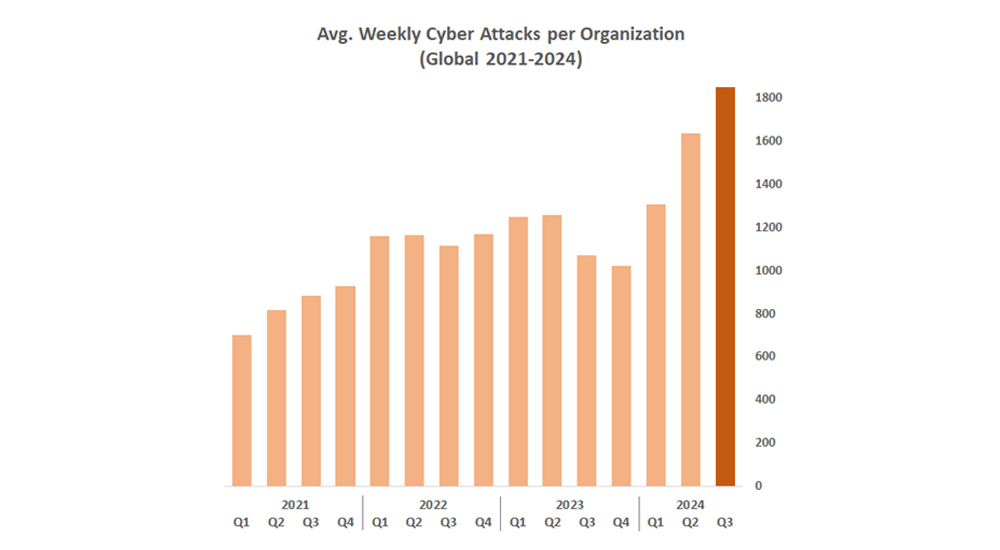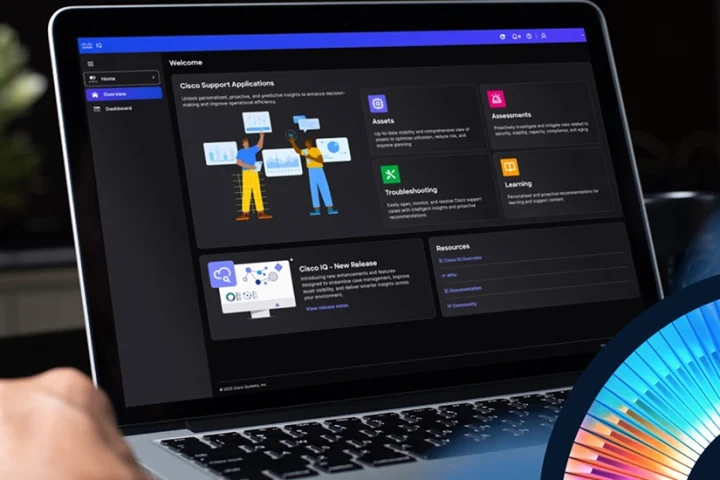The digital landscape witnessed an unprecedented surge in cyber attacks worldwide in the third quarter of 2024. This period marked a significant escalation in both the volume and intensity of cyber threats organizations face, shedding light on cybercriminals’ evolving tactics and the urgent need for reinforced cyber defenses.
A Record Spike in Attacks
The third quarter of 2024 saw the average weekly cyber attacks per organization climb to an all-time high of 1,876, marking a staggering 75% increase from the same period in 2023 and a 15% uptick from the previous quarter. This surge underscores the trend that virtual threats are becoming more frequent and sophisticated.
Industry-wise Breakdown
The Education/Research sector emerged as the most targeted industry, averaging 3,828 weekly attacks per organization. The Government/Military and Healthcare sectors were not far behind, with 2,553 and 2,434 weekly attacks, respectively. Notably, the Hardware Vendor industry experienced the most significant year-over-year increase, with attacks soaring by 191%.

Regional Highlights
On a regional scale, Africa bore the brunt of cyber threats, with organizations facing an average of 3,370 attacks per week, a 90% increase from the previous year. Europe and Latin America also saw substantial rises in attack frequencies, indicating that no region is immune to the global uptick in cyber hostility.
| Region | Avg. Weekly Attacks per Organization | YoY Change |
| Africa | 3370 | +90% |
| APAC | 2863 | +55% |
| Latin America | 2844 | +72% |
| Europe | 1557 | +86% |
| North America | 1298 | +55% |
Ransomware: A Persistent Threat
Although slightly less than the previous year, ransomware attacks remained a formidable challenge, with more than 1,230 incidents made public by extortion groups. North America was the most affected, accounting for 57% of all reported incidents, followed by Europe at 24% and APAC at 13%. The Manufacturing sector emerged as the most impacted, making up 30% of reported attacks, highlighting the broad reach of ransomware across different industries. The Healthcare sector followed with 13%, while the Retail/Wholesale sector accounted for 10%.
| Industry | Percent of Published Ransomware Attacks |
| Manufacturing | 30% |
| Healthcare | 13% |
| Retail/Wholesale | 10% |
| Education/Research | 8% |
| Finance/Banking | 8% |
| Insurance/Legal | 6% |
| Government/Military | 6% |
| Communications | 5% |
| Software vendor | 4% |
| Transportation | 4% |
| Leisure/Hospitality | 3% |
| Utilities | 2% |
| Consultant | 2% |
| SI/VAR/Distributor | 0.4% |
| ISP/MSP | 0.1% |
Focus on the United Arab Emirates
In the UAE, cyber attacks have risen by 63% year-over-year, with organizations experiencing an average of 1,590 attacks per week—up 3% from the previous quarter. This escalating threat highlights the critical need for advanced, prevention-first cyber security solutions to stay ahead of increasingly sophisticated risks in the region.
The Way Forward
The data from Q3 2024 serves as a stark reminder of the ever-evolving cyber threat landscape. Organizations worldwide must prioritize strengthening their cyber defenses and fostering a culture of cyber resilience. As cybercriminals continue to refine their tactics, staying ahead of the curve is not just advisable—it’s imperative.
The increasing frequency and sophistication of cyber attacks underscore the need for comprehensive security strategies beyond traditional defenses. The following strategies are based on best practices from Check Point Software:
- Advanced Threat Detection: Use technologies like sandboxing and anti-ransomware tools to identify and block sophisticated attacks.
- Implement Zero Trust Architecture: Enforce strict identity verification for every individual and device trying to access network resources.
- Regular Data Backups and Incident Response Planning: Regularly back up critical data and create comprehensive incident response plans to deal with attacks and minimize their impact promptly.
- Strengthen Security Posture: Keep systems updated and patched regularly to address vulnerabilities. It is crucial to have multiple layers of security, including firewalls and endpoint protection.
- Employee Education and Awareness: Regular training sessions can inform employees about the latest risks and phishing techniques, promoting a culture of vigilance.
- Network Segmentation: Isolate critical systems to contain the spread of attacks and safeguard sensitive information.
- Vulnerability Management: Conduct frequent vulnerability assessments and penetration testing, prioritizing efforts to address potential impacts.
By adopting a proactive approach to cyber security, organizations can safeguard their assets and ensure the continuity of their operations in the face of an ever-changing threat landscape.
The statistics and data used in this report present data detected by Check Point ThreatCloud AI platform, which analyzes big data telemetry and millions of Indicators of Compromise (IoCs) daily. Our threat intelligence database is sourced from 150,000 connected networks, millions of endpoint devices, Check Point Research (CP), and dozens of external feeds. Over 50 AI-powered engines provide weekly reports on attacks our solutions prevented, and organizational networks Check Point protected, broken down by country and sector




















